




































































































































































































































































































































































































































































































































































































































































































































































By Conrad H. Blickenstorfer; photography by Carol Cotton
RuggedPCReview.com took a detailed look at Emdoor's EM-T50 rugged Android handheld. The review is a little different from our usual rugged device reviews because the EM-T50, and in fact all of Emdoor Info's computing products, are OEM designs and not branded products that will directly go to end-user customers. In other words, in addition to making available products like the rugged EM-T50 handheld that's the subject of this review, Emdoor Info can design and manufacture products per customer specifications. So let's start with a brief introduction to Emdoor Info first.
Emdoor was founded in 2002 as a designer and manufacturer of rugged handhelds, tablets, notebooks, PCs, and vehicle mount computers, as well as a provider of customized hardware and software solutions. Even today, Emdoor doesn't sell products under its own brand name, although that may happen at some point in the future. For now, Emdoor is one of the largest and most experienced Chinese providers of rugged computing systems and serves as an ODM or OEM partner to many Tier One companies.
Emdoor Info has its headquarter and a factory in Shenzhen, and also an R&D team of over 300 people. They can produce 15,000 to 30,000 rugged devices a month, and currently have a roster of about 50 rugged mobile products. Emdoor's goal is to provide cost-efficient industrial hardware and sometimes also software solutions for use in warehouse logistics, industrial automation, health care, petroleum exploration, outdoor mapping, automotive inspection, road enforcement, education, border patrol, retail services, self-service terminals, machine vision, smart home, intelligent transportation, and the like.
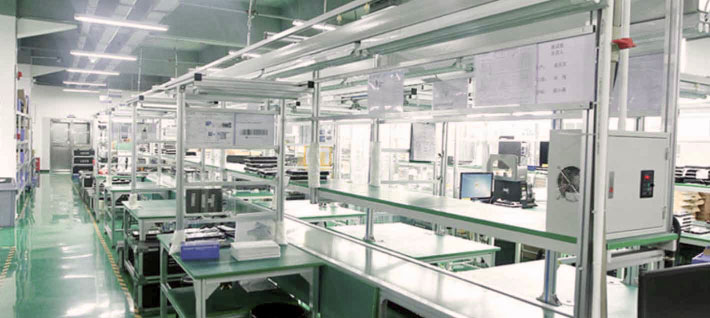
While in this article we're covering the company's EM-T50 rugged Android handheld specifically, much of the discussion centers not only on this particular tablet product, but on OEM market products in general.
In the past, most electronics made their own products right in the country where they were located. Some parts may have been outsourced or produced elsewhere, but for the most part, everthing was designed, manufactured and assembled in one place. A prime example of that approach was Henry Ford's giant Rouge factory in Detroit. Iron ore and other raw materials went into the huge complex on one side, and fully assembled cars came out on the other.
Today's marketplace is a global one, and producing everything in one location is generally no longer feasible. There are, of course, exceptions, but for the most part components are procured from all kinds of places and assembled in various locations, all depending on cost, logistics and profitability. This dynamic gave rise to the formation of OEMs — Original Equipment Manufacturers — and ODMs — Original Design Manufactures. OEMs make a product per the exact design and specifications of the company that ultimately sells the product with its name on it. ODMs design and manufacture a product entirely by themselves. and then sell the product to companies who put their name and brand on it.
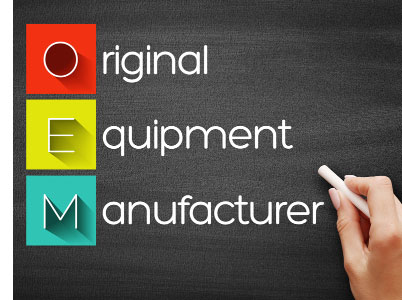 What roles are OEMs and ODMs playing today? Very important ones. Almost all consumer electronics products today are no longer manufactured by the companies most people think make them. Few who are not industry insiders, for example, have heard of Hon Hai Precision Industry. Better known as Foxconn, Hoi Han had 2020 revenues of US$181 billion. That's way more than the annual revenues of Microsoft, HP, IBM or Dell.
What roles are OEMs and ODMs playing today? Very important ones. Almost all consumer electronics products today are no longer manufactured by the companies most people think make them. Few who are not industry insiders, for example, have heard of Hon Hai Precision Industry. Better known as Foxconn, Hoi Han had 2020 revenues of US$181 billion. That's way more than the annual revenues of Microsoft, HP, IBM or Dell.
What's the impact of this on the rugged mobile computing market? At this point a large variety of rugged handhelds, tablets, laptops and panel PCs are made by OEMs and ODMs, and then sold under names familiar to end users and local may be structured in many different forms. An OEM may manufacture a product line to very precise specifications for one customer only, and that customer may have an exclusive to the line. Such products are then only available from only one single company, in essence making them a "virtual manufacturer." It is, however, also common that an ODM creates a product and then sells that exact product to several customers. Those customers may then put their label on it and nothing more. Between those two extremes are many shades of gray.
Hoes does all of that apply to Emdoor Info and the EM-T50 rugged Android handheld? Emdoor is both an ODM and an OEM, and one that specializes in making rugged computing products. Emdoor's customers are companies that provide rugged technology to their own end user customers. The rugged computing market is, of course, way smaller than the consumer technology market, and Emdoor is much smaller than Foxconn (which gets about half of its revenue from Apple). But it's basically the same thing.
Who are Emdoor's customers? It is mostly companies catering to their own and often specialized markets. Emdoor's customers sell rugged computing equipment to companies that combine the hardware with their name, history, expertise, software, turn-key solutions, service, and consulting arrangements. Emdoor's customers may be large, well established names in their fields. Such customers may have precise customization requirements, their own color schemes, and their own brand names. But Emdoor's customers might also be resellers, large end users, system integrators, and more.
While many customers like doing business with one of the major rugged hardware and services brands, for others working with an OEM/ODM like Emdoor makes more sense. As an OEM/ODM, companies like Emdoor can offer cost advantaged. OEM/ODM designs are more easily customizable to meet the needs of different customers, including personalizing products with established labels, color schemes, and materials. OEM/ODMs are also more likely to offer a large variety of I/O and they may support different technologies, standards, and performance levels.
So let's look at the EM-T50 and see how the company went about the difficult job of creating a rugged Android handheld that merges the look and appeal of a generic modern smartphone form factor with the toughness and functionality of a handheld computer for the job. Below you can see the EM-T50 from the front, from all four sides, and from the back.
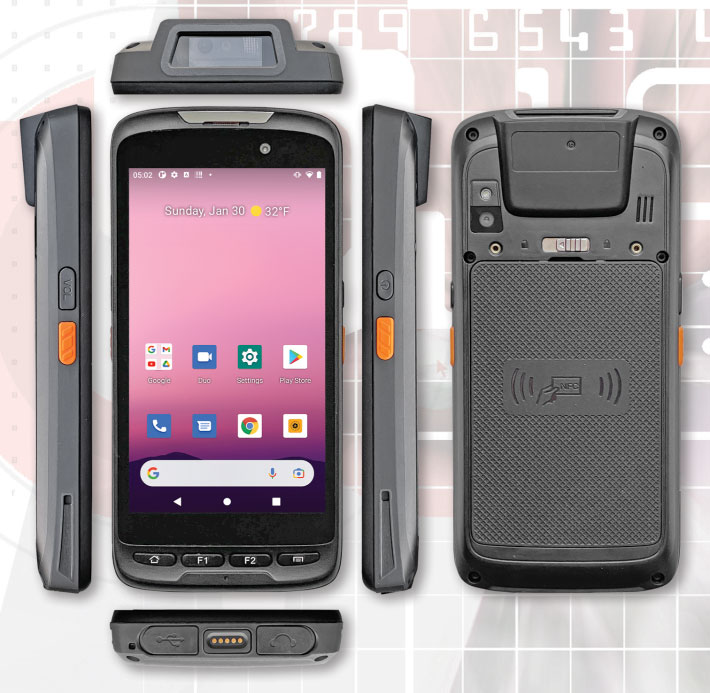
Unlike the company's rugged EM-T60 5.7-inch handheld which has a smartphone-like design with internal battery and without any physical buttons, the T50 is more like a small handheld computer with replaceable battery and a number of physical buttons that are more easily operated with gloves on. The device is still just the size of a modern smartphone with a footprint of 6.3 x 3.15 inces and a thickness of 0.65 inches. despite its inherent ruggedness and integrated industrial-grade scanner, the T50 weighs no more than an iPhone 13 Pro Max in its Apple protective sleeve.
The T50 doesn't have, or need, protective corner bumpers or protrusions; its strong case provides enough of a margin around the display to offer plenty of protection. Unlike many modern smartphones where the display extends to the perimeter of the devices and sometimes even wraps around (making them fragile as well as awkward to hold and operate), the T50 screen has a margin around the actual LCD, making it easy to hold and work on. The display is slightly recessed into the housing, adding even more protection.
Below the screen are four physical buttons: Home, two custom-assignable buttons, and a Menu button. Users can operate the T50 either via the three traditional Android software buttons or set it to "modern" gesture navigation using swipes to go home, switch apps or go back

Since the Emdoor EM-T50 doesn't need a case to handle everyday work and life, all of its buttons and controls are easily accessible. On the left side that's a volume button (which, oddly isn't a rocker but cycles through volume settings) and an orange scanner button. On the right side are another orange scanner button and the on/off button, and a programmable button.
When it comes to rugged mobile computers — be they handhelds, tablets or laptops — the inside matters as much or more than the outside. A strong chassis and the absence of components that may come loose are all essential for the durability and ruggedness of a device. And that is why we disassemble test devices in our lab whenever we can. The EM-T50 comes apart easily: undo six small Torx T5 screws and another four very small Phillips screws and the two halves come apart, without any ribbons or wires between the two.
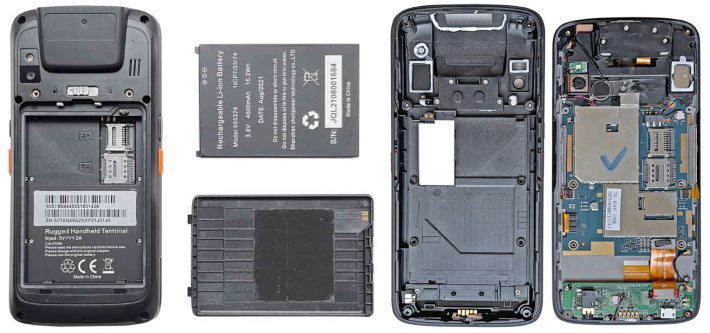
Unlike the Emdoor EM-T60 we recently examined (see here), the T50 has a removable battery. The advantage of that approach is that users can quickly put in a fully charged spare battery and continue work. The 3.8V/4,000mAh battery packs 15.2 watt-hours and sits in its own compartment that also houses the T50's micro SD and SIM card slots. A plastic cover with a tongue-and-groove seal keeps liquids out. The device will not power up unless that cover is firmly in place, and do make sure the o-ring seal is fully sitting in its groove.
In terms of construction, the EM-T50 consists of black polymer front and back, with a magnesium chassis attached to the front, providing strength and rigidity. Sealing, again, is via a tongue-and-groove design with a slender o-ring around the perimeter of the handheld. White silicon glue provides a watertight seal around any openings.
OEM companies like Emdoor must carefully plan the overall performance levels of their mobile computing product offerings. In addition to the usual size/weight/cost tradeoffs and balancing inherent
 in any mobile design, OEM customers may have widely differing priorities, ranging from lowest possible cost to highest possible performance. That conundrum is relatively easily addressed in Windows tablets or laptops that may be available with a wide range of processors of difference performance levels, that option isn't available with handheld computers. Each model comes with its own chip, and OEMs must choose that one carefully.
in any mobile design, OEM customers may have widely differing priorities, ranging from lowest possible cost to highest possible performance. That conundrum is relatively easily addressed in Windows tablets or laptops that may be available with a wide range of processors of difference performance levels, that option isn't available with handheld computers. Each model comes with its own chip, and OEMs must choose that one carefully.
| Performance | Emdoor Info | Emdoor Info | Emdoor Info | |
| Model (version tested) | EM-T50 | EM-T60 | EM-T40 | |
| Year tested | 2022 | 2021 | 2022 | |
| Processor | MediaTek | MediaTek | MediaTek | |
| Processor Model | MT6762 | MT6762 | MT6762 | |
| CPU Speed | 2.00/1.50 GHz | 2.00/1.50 GHz | 2.00/1.50 GHz | |
| Cores | Octa-core | Octa-core | Octa-core | |
| AnTuTu | 95,367 | 95,380 | 96711 | |
| PC Mark Work 3 | 4,915 | 4,971 | 4,992 | |
| - PC Mark Browsing | 4,327 | 5,074 | 4,483 | |
| - PC Mark Video Editing | 4,489 | 4,256 | 4,487 | |
| - PC Mark Writing | 4,851 | 4,310 | 4,840 | |
| - PC Mark Photo Editing | 8,285 | 8,901 | 8,383 | |
| - PC Mark Data Manipulation | 3,675 | 3,664 | 3,798 | |
| - PC Mark Battery Life | 10:32 hrs | 11:57 hrs | 11:37 hrs | |
| Geekbench 5 Single Core | 151 | 152 | 149 | |
| Geekbench 5 Multi Core | 865 | 934 | 838 | |
| Geekbench 5 Vulkan | 85 | 73 | 82 |
Everyone, of course, loves the kind of effortless responsiveness that makes modern smartphones so easy and pleasant to use, and the performance that won't slow things down even when running demanding apps. All smartphones look pretty much the same, and that's why consumer smartphone makers seek to differentiate themselves from the competition with new and faster chips each year, as well as better cameras, more memory and so on. All that comes at a price that not everyone can pay. And price is definitely a big issue in OEM designs.
The latest top-of-the-line SoCs (System-on-Chips) are way too expensive to be feasible for most OEM devices, and so OEMs will/must select SOCs that are fast enough to get the job done at a low enough cost to be financially feasible for the OEM, the OEM's customers, and the end user.
What Emdoor did with the EM-ET50 is use an octa-core SoC from MediaTek. While not as well known as Qualcomm and its SnapDragon chips that are in most high-end Android phones, MediaTek is actually the world's largest smartphone application processor supplier.
The Helio P22 MT6762 Emdoor chose uses eight Cortex A53 cores, four running at up to 2.0GHz and the other four at up to 1.5GHz. The idea here is speed when needed, and economic operation when maximum speed doesn't matter. The SoC includes a 600MHz PowerVR GE8320 and also controls other important system functions. It is a popular chip used in many devices by most leading smartphone makers.
It is, however, not the latest and greatest. The Helio P22 was introduced almost four years ago and it definitely gets the job done. But the emphasis here is in a balance between cost and performance that works for OEMs and OEM customers.
The table above shows the EM-T50's performance in some of the leading Android benchmark test suites. Overall, it performed at the level of SnapDragon SD450-based devices, which is very respectable for an OEM device. Compared to relatively recent popular higher end models based on the SD855 we saw roughly half the PCMark 10 Works 3.0 performance. For comparison we also added the results of Emdoor's EM-T60 and EM-T40, both of which are based on the same SoC.
What kind of battery life can one expect from the Emdoor EM-T50 rugged handheld? Emdoor claims eight to ten hours from a charge of its 3.8 Volt, 4,000mAH, 15.2 watt-hour battery. Battery life, of course, is very relative and depends on how a device is used. The screen captures below show both the results of the EM-50T's performance in PCMark for Android's Work 3.0 performance score as well as how it did in PCMark for Android's Work 3.0 battery life test and rundown.
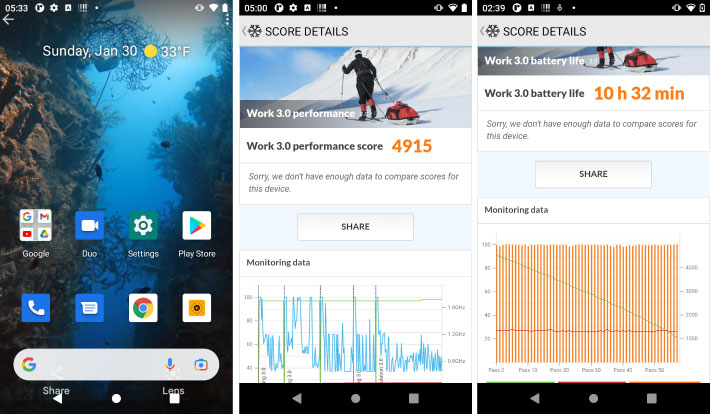
PCMark for Android's Work 3.0 test consists of running a long list of everyday tasks, the kind of work a user may encounter while using the device for daily work. The battery life test keeps running that suite until the battery is exhausted, without turning the device ever going to sleep (we calibrated the system to operate at PCMark's recommended 200 nits luminance). In that test, the EM-ET50 ran for 10 hours and 32 minutes, never stopping work. Almost no one uses their work handheld constantly for over ten hours, so real life battery life may well be higher yet. That is excellent.
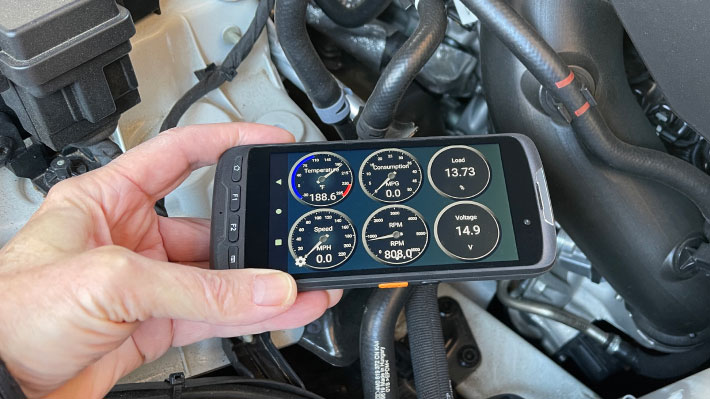
Modern smartphone displays are generally in the 5 to 6.5 inch (diagonally) range. It's hard to imagine that the standard screen size of early Windows Mobile-based Pocket PCs — both consumer and industrial — were just 3-1/2 inches, and that's also what the initial iPhone was. Times sure have changed, and somehow everyone has gotten used to smartphones and handheld computers with screens far larger than people used to think fit comfortably into pockets.
And yet, the vast majority of smartphones sold today have screens larger than 5.5 inches. Which means the EM-50T's 5.0-inch is a bit smaller than that. Rugged industrial and enterprise handhelds usually have somewhat smaller screens due to their larger bezels that provide extra protection.
The Emdoor EM-T50s capacitive multi-touch IPS display has 720 x 1280 pixel resolution. That makes for 294 pixels per inch. That is very sharp and definitely falls into what Apple calls the "retina" category, i.e. it's so sharp that you can't see indvidual pixels. 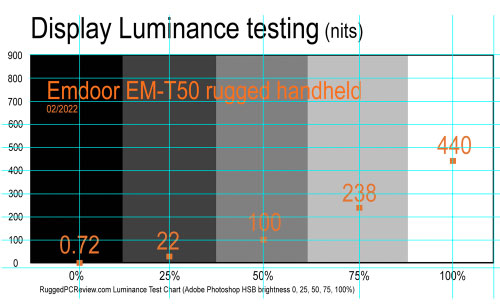 There are consumer smartphones now with well over 600 ppi, but that seems a marketing issue much more than a need. Since this is an IPS screen, there are perfect viewing angles and no color or contrast shifts when viewed from any angle.
There are consumer smartphones now with well over 600 ppi, but that seems a marketing issue much more than a need. Since this is an IPS screen, there are perfect viewing angles and no color or contrast shifts when viewed from any angle.
Display brightness is very important for easy viewability outdoors. No current display can, of course, match direct sunlight, but display technology has advanced to a level where we can expect good outdoor viewability under most conditions, and the EM-T50 is no exception.
What makes a display appear bright is its luminance, and that is usually measured in "nits." Nits is actually candela per meter squared, or cd/m2, and that, per Google dictionary, is "the luminous intensity, in a given direction, of a source that emits monochromatic radiation of frequency 540 × 1012 Hz and has a radiant intensity in that direction of 1/683 watt per steradian." No wonder they just call it nits.
Emdoor's spec sheet claims 350 nits for the EM-T50 display. Premium consumer tablets and smartphones can go as high as 500 and 600 nits, so 350 seems on the low side. In our testing we found the EM-T50 display to actually be a good bit brighter than its listed 350 nits — our test equipment measured 440 nits.
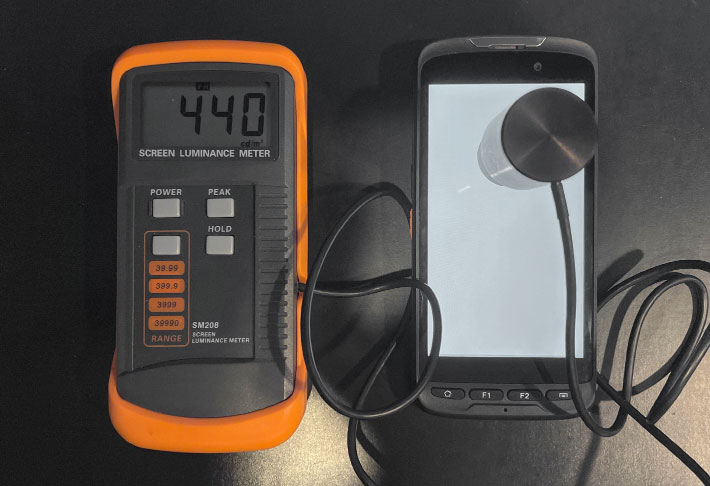
Like almost all smartphone and tablet displays today, the EM-T50 has a "glossy" transmissive screen with optical treatments to offer as much outdoor viewability as possible. Glossy screens "pop" and make for vibrant displays, but outdoors it all depends on angle and reflections. The pictures below show the handheld outdoors on a late afternoon under various viewing conditions. In shaded areas it's bright and very readable. Like in all devices using glossy screens, there will be reflections that dim the screen some.
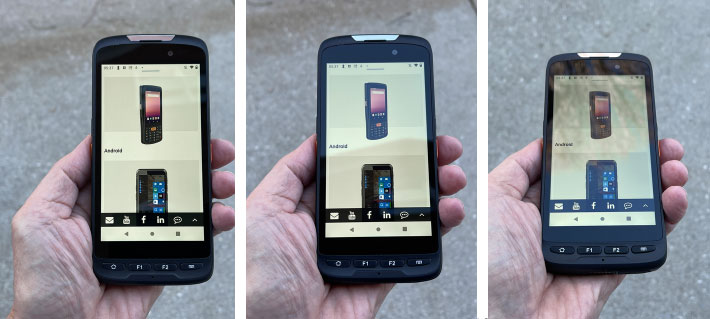
Overall, the EM-T50 display is very good. It's bright and vibrant indoors, and bright enough for outdoor use. It offers near perfect viewing angles from all directions, without distracting changes in brightness, color, or contrast.
Bar codes are everywhere, and they have also pretty much become the glue that binds the storage and movement of goods to the overal global information infrastructure. Even smartphones can read those coses now by using their cameras, but for professional use one needs an industrial-grade scanner, and Emdoor offers a choice of three for the EM-T50. And, as the image below shows, while adding a scanner does add a bit of height, it does with adding just a small bump to the top of the unit. 
The EM-T50 comes standard with a Zebra SE4710 1D/2D imager (see here). The SE4710 (shown above left) is a higher-end 1D/2D scanner with red aiming LED, a scan range of about 2 to 30 inches  (depending on the type of code), and a combination of onboard software/hardware scanning for faster capture and processing.
(depending on the type of code), and a combination of onboard software/hardware scanning for faster capture and processing.
The latter includes Zebra's PRZM Intelligent Imaging technology that offloads a portion of the processing from the decode software to the scan engine for overall faster data capture.
Emdoor also offers OEM customers a pistol-style scanning trigger and two additional scanner options.
Like virtually every smartphone and handheld computer these days, the Emdoor EM-T50 has both a front and a rear camera. The front one is primarily for WiFi video calls and conferencing and offers 5-megapixel resolution, more than most rugged devices. The rear camera is for documentation and general photography and comes with 13 megapixel resolution and with auto-focus.
The included Android Camera app in our review unit could take pictures with resolutions as high as 16mp (4608 x 3456 pixels), also also offered five additional resolutions from 1mp to 9mp in 4:3 and 16:9 aspect ratios. Other settings include self timer, white balance (8 modes), scenes (14 modes), ISO (6 modes), ZSD (Zero Shutter Delay), and anti-flicker.
In video mode, the there are four resolutions, topping out at 1920 x 1080. 4K video would have been nice; the imager could easily support it. There are 13 scene modes, anti-flicker and microphone-on /off. Video quality is good, but many will miss higher resolution modes.
The pictures below were shot with the EM-T50's rear camera in 13mp 4096 x 3072 mode. Click on the image to bring up a full-size version.

Given the incredible imaging quality of today's smartphones, users have come to expect a lot from their mobile device cameras. Higher end models have multiple cameras and lenses. As a handheld computer for data collection work the EM-T50 doesn't and the camera app is basic, but picture quality is much better than the cameras usually integrated into rugged handhelds and tablets.
While most consumer smartphones are fashion items with sleek design and the latest technology, OEM/ODM devices like the Emdoor EM-T50 handheld are tools for work. They are designed to get the job done without constantly worrying they may break. Any time you're more concerned with not scratching and not breaking a tool than actually using it the way it's supposed to be used, you have the wrong tool. The EM-T50 is not one of those fragile tools. It may look like a modern smartphone, but it is really a mobile computer that's much more solid than today's fragile consumer smartphones.
Unlike modern smartphones that need a protective case to survive, the EM-T50 doesn't need a case and it can be used without worries that it might break or get scratched or dented. There is no need from a screen protector either because the screen glass is thick and strong enough (Emdoor's website shows cars driving over their rugged handhelds). The screen also has a bezel around it and is very slightly recessed to provide extra protection against breakage from falls.
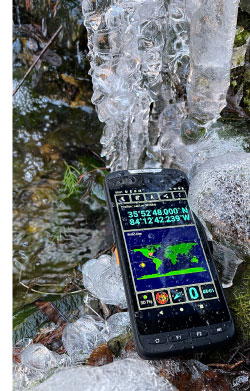 By established ruggedness testing standards, just how tough is this tablet? That's a bit more difficult to determine. The EM-T50 carries IP65 sealing where the "6" means it's completely dustproof, and the "5" that it is also protected against leaking/damage from low pressure water jets from all directions. It can handle rain and worse, but not full immersion like the Emdoor EM-T60. As the image below shows, we took that to the test.
By established ruggedness testing standards, just how tough is this tablet? That's a bit more difficult to determine. The EM-T50 carries IP65 sealing where the "6" means it's completely dustproof, and the "5" that it is also protected against leaking/damage from low pressure water jets from all directions. It can handle rain and worse, but not full immersion like the Emdoor EM-T60. As the image below shows, we took that to the test.
The EM-T50 can also handle drops from four feet. That means it can easily survive falling off a desk or a cart. And four feet is also about the distance a tablet falls if it slips out of one's hands while using it in a standing position.
The stated operating temperature range of -4 to 131 degrees Fahrenheit (-20 to 55 degrees Celsius) is wide enough for just about any deployment short of extended use in commercial freezers or arctic settings.
Emdoor literature and spec sheets also refer to a "50-100 cycles rolling test" as well as the screen being able to withstand a 64 gram steel being dropped on it from 110 cm.
The pictures below show some of the test procedures all Emdoor rugged products must go through. These include, in no particular order, waterproofing and air tightness, high and low temperature, salt spray corrosion, bare metal drop test, roller test, impact resistance, vibration resistance, screen ball drop, protective door testing, friction testing, static testing, color testing, chemicals and rub-down testing, and more. What we'd like to see more of are references to this testing compliant with the procedures outlined in the MIL-STD-810G/H standards in the product spec sheets.

Emdoor also provides product certification services both for governmental as well as for private technical commissions and software/standards licensing.
With the EM-T50 Rugged Android Handheld, Emdoor Information offers OEM customers a solid, functional and robust data collection computer for all sorts of commercial and industrial applications. The EM-T50 is no larger and just a tad heavier than a modern smartphone, looks and works like one, but provides the ruggedness and data collection capabilities of an industrial-grade handheld computer.
The EM-T50, which runs on Android 11 GMS, is a handheld designed for work and is much tougher than any modern smartphone. It's 5.0-inch 720 x 1280 pixel IPS display is bright enough (440 nits in our testing) and has excellent viewing angles.
The device comes with industrial-grade 1D/2D barcode scanner from Zebra (two other scanner options are available). It has a good 5mp front camera for video calls and conferencing. The 13mp documentation camera is also considerably better than most cameras found in rugged handhelds. The T50 has a 15 watt-hour battery good for ten hours or so on a charge. The is replaceable and can be exchanged for a fresh one during extended shifts.
The unit's octa-core MediaTek MT6762 SoC provides decent performance, but is not at the level of the latest premium consumer smartphones. WiFi, Bluetooth, NFC and GPS are all standard; mobile broadband is optionally available. The device has a micro SD card and a nano-SIM card slot in its battery compartment.
Overall, the EM-T50 is a modern, competent option for OEM customers who seek an easy-to-use data collection handheld that combines modern smartphone functionality with industrial handheld ruggedness and features.
-- Conrad H. Blickenstorfer, February 2022
LEARN MORE: Emdoor's EM-X33 rugged laptop computer reviewed by Conrad H. Blickenstorfer, a editor of RuggedPCReview.
https://lnkd.in/gjJxSJBu

Grazie per la tua attenzione sul PC robusto Emdoor!
Si prega di riempire il modulo per far sapere la tua necessità. Ci daremo in contatto con te al più presto.